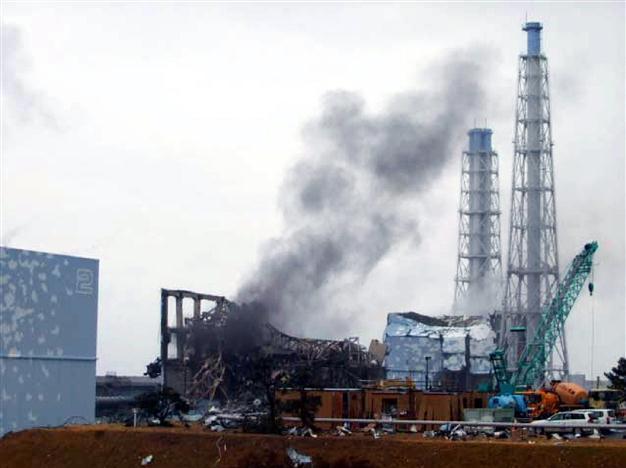Japan says Fukushima reactors now stable
TOKYO - Agence France-Presse

This handout file picture released from Tokyo Electric Power Co (TEPCO) on March 21, 2011 shows black smoke rasing from the third reactor building of TEPCO's Fukushima Dai-ichi nuclear power plant at Okuma town in Fukushima prefecture AFP Photo
Japan said Friday it had finally brought leaking reactors at Fukushima under control, in what authorities say is a vital step on the long road to recovery, nine months after its nuclear crisis began.Prime Minister Yoshihiko Noda told a meeting of his nuclear taskforce that the crippled reactors "have reached a state of cold shutdown to the point where the accident is now under control", Jiji Press reported.
The government is hoping that the announcement will bring relief to a disaster-weary public still haunted by the effects of the monster tsunami that tore into Japan in March.
Stabilisation of the reactors, whose molten cores spewed radioactive particles into the air and sea, marks the end of what the government has dubbed "Step Two" of the clean-up.
The initial success of Step One -- the stable cooling of reactors and used fuel pools -- was announced in July, after the quake-triggered tsunami pummelled the plant on March 11 and laid waste to much of the northeast coast.
"This step (Step Two) means that the reactors have continued to be in a stable condition for some time, so we can consider that they are now under control," said Takashi Sawada, vice chairman of the Atomic Energy Society of Japan, a pro-nuclear group of academics and industry specialists.
Sawada stressed that the use of the term "cold shutdown" by the government and plant operator Tokyo Electric Power (TEPCO) did not indicate that all four disaster-hit reactors were now safe.
"But I think it's okay to say that the reactors have basically reached a stable condition of cooling," he said, adding the amount of radiation leaking from the plant is now a tiny fraction of what it was in March.
Tetsunari Iida, director of the Institute for Sustainable Energy Policies, an anti-nuclear group, said some of the terminology was a little misleading.
"The terms 'cold shutdown' and 'decommissioning' are being used differently from the way they are supposed to be. I'm worried these words may be giving the impression that everything is going to be alright now." "The decommissioning they are talking about does not mean what we usually think of" where fuels are removed and the facility is taken apart.
"Decommissioning for them is to wrap up the accident. This will take 40 years or so. They may not even be able to take out the fuel and could have to cement the whole thing down." After the March disaster, an exclusion zone around the plant was established with tens of thousands of people evacuated to avoid their being exposed to dangerously high levels of radiation.
Swathes of this zone remain polluted, with the clean-up proceeding slowly amid warnings that some towns could be uninhabitable for three decades.
While the natural disaster claimed 20,000 lives, the nuclear emergency has recorded no direct casualties. But it has badly dented the reputation of a technology on which Japan previously depended for a third of its electricity.
Prime Minister Noda was scheduled to make a formal announcement at 0900 GMT, Chief Cabinet Secretary Osamu Fujimura said, while adding: "Even after completing Step Two, it does not mean an end (to the disaster). The (nuclear) taskforce will certainly continue coping with it." On March 11, waves up to 14 metres (45 feet) high swamped the reactors' cooling systems, sparking meltdowns, explosions and the release of radioactive material in the world's worst nuclear accident since Chernobyl in 1986.
TEPCO was caught short by the disaster, with its tsunami defence systems overwhelmed and back-up power generators knocked offline, leaving a small band of men -- dubbed the Fukushima 50 -- to try a series of ad hoc solutions, including the use of seawater to cool the melted fuel rods.
Water used in the cooling process subsequently became a major headache for TEPCO, which had to release tonnes of the contaminated liquid into the Pacific, provoking the ire of fishermen both locally and in South Korea and China.
Farmers in the area also suffered, with produce shunned by consumers or banned by the government because of radioactive contamination.
Sawada at the Atomic Energy Society said another big quake or tsunami could undo the hard work at Fukushima, and stressed that decommissioning the reactors and cleaning up the surrounding area would last decades.
















